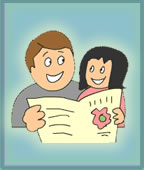 Our phonics books make it easier (and more fun!) to teach children how to read. Better still, ANYONE can use them, which makes it ideal for parents, home-schooling, teacher assistants, volunteers and teachers who need more resources.
Our phonics books make it easier (and more fun!) to teach children how to read. Better still, ANYONE can use them, which makes it ideal for parents, home-schooling, teacher assistants, volunteers and teachers who need more resources.
– Concurrent reading and handwriting instruction.
– Teaches phonics AND the important sight-words that break phonics rules.
– Teaches the rest of the information that children need to know to become independent readers (plurals, contractions, syllables and the basics of punctuation—who can read English without those?).
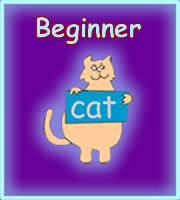 |
Beginner Phonics Books:: For children who already know their alphabet, these books teach the five short vowels (a, e, i, o and u) as well as some of the variations of the pronunciation of the letters "s" and "f" (as in is, his, as, and of). |
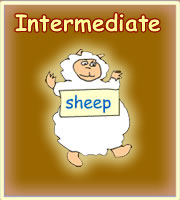 Intermediate Phonics Books Intermediate Phonics Books |
Intermediate Phonics Books:: These books teach long vowels and the consonant blends and digraphs. |
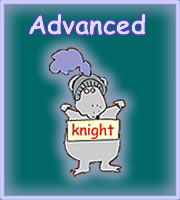 Advanced Phonics Books Advanced Phonics Books |
Advanced Phonics Books:: These books teach advanced long vowels, syllables, basic punctuation, silent letters, R-controlled vowels, W-controlled vowels, L-controlled vowels, basic homonyms and the common words that break these phonics rules. For a full overview of the subjects taught in this book series, please see our Guide to the Advanced Books. |
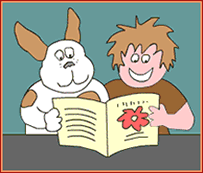 Progressive Phonics is an all-in-one reading program that is easy, fun, and totally FREE---that's right, totally and completely free!
Progressive Phonics is an all-in-one reading program that is easy, fun, and totally FREE---that's right, totally and completely free!
And with Progressive Phonics, ANYONE can teach a child to read and write in just a few minutes a day, which makes it ideal for parents, teachers, tutors, volunteers and home-schoolers.
No experience necessary. Just pick a book and start reading it with your child/students.
Matching handwriting worksheets and activity sheets for each book -- when children write what they learn, they learn it better.
Also teaches the essential sight-words (and phonics rule-breakers) that most phonics programs fail to teach.
Instant access -- download and use today.
Our books can be read on-screen or printed on your color printer. Each book takes 4--8 minutes to print and uses as little ink and paper as possible.
But don't judge a book by it's home page. Read one of our books with a child and see for yourself.
"Thank you so much for this amazing series. It is ideal because of the grammar. I teach children that experience learning difficulties. Often these children are very bright and need something that is enjoyable and stimulating. They simply love it and enjoy coming to the support classes. It is amazing to see how more confident they are. They are also willing to pick up other books and explore." R.V.
"These books are great. They are really helping my 7 year old overcome some of his difficulty in reading. They are so much fun!! I have recently started using them with my 5 and 4 year old daughters. They love them too. They are really going to be prepared for Kindergarten and Jr. K come this fall. Thank you for this wonderful resource, from a mother of 3 with #4 on the way !!!!"
Hello there!
We have emailed you (maybe you haven't received it yet or maybe your email address has changed), but things have changed here at Progressive Phonics, and we wanted to tell you what was going on.
As some of you may remember, our books used to be free. This was way back in 2006 when we were first developing our books.
However, development costs money, and in order to develop Version Two of the books, we had to get financing from somewhere -- so we started selling our books on the internet.
With the money from the sales (and with other money we begged and borrowed) we created the Alphabetti books and also upgraded our Beginner and Intermediate phonics books.
But our dream was always to go back to the old days, when we allowed people to download copies of our books for free on the Internet. There's a warm and fuzzy feeling that comes from knowing that little kids around the world can go to the Internet and learn how to read.
By an amazing stroke of luck, we have landed a sponsor to help finance the remaining development of our books, which means that we no longer need to sell the download versions of our books.
At this point, some of you may be saying, "Oh, shoot! I just purchased the #*@*! books!"
Well, to anyone who has purchased the books in the last 30 days, we are more than happy to refund your money. :-) Send an email to finance@progressivephonics.com and tell us the name you used to make the purchase, and we'll do everything we can to get your money refunded ASAP.
And to everyone else, THANK YOU, THANK YOU, THANK YOU. Without your support, we would not have been able to continue the development of our books.
- - - -
WE ALSO HAVE DISCUSSION FORUMS AT THE NEW WEBSITE. This will make it much easier for us to handle questions and comments. (We were NOTORIOUSLY bad about answering email... yikes, sorry about that.)
In any case, we hope you like the new web site.
Sincerely,
Miz Katz N. Ratz and
her mighty assistants
I don't know how to do this but here goes....
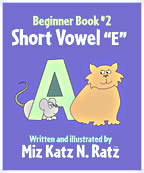 Beginner Phonics Book 2
Beginner Phonics Book 2Short Vowel "E", focuses on short vowel "e" (red, yes, let, etc.) and teaches a fun trick on how to remember "b" versus "d."
Number of pages: 35
Alpbabet letter focus: e,b,l,v,w,y.
Words used: Ted, ten, red, bed, Ed,let, vet, wet, yet, yes (and the words bad and van). Of these words, ten, red and let are Dolch words. (See info on Dolch words.)
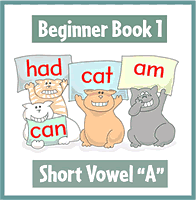 Al and Hal
Al and HalStory synopsis: Al the sheep learns to change his messy ways. Practices the letter "L" at the end of words.
Letters taught: Lowercase Letter 'L' at the end of words.
"Easier" version: Only has the words "al" and "hal" (both are boy's names).
Regular version: Words taught: al, at, sat. hal, can.
# of pages: 28
=============================
=======================
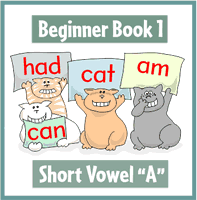 Al and Hal
Al and HalStory synopsis: Al the sheep learns to change his messy ways. Practices the letter "L" at the end of words.
Letters taught: Lowercase Letter 'L' at the end of words.
"Easier" version: Only has the words "al" and "hal" (both are boy's names).
Regular version: Words taught: al, at, sat. hal, can.
# of pages: 28
=============================
=======================
 Al and Hal
Al and HalStory synopsis: Al the sheep learns to change his messy ways. Practices the letter "L" at the end of words.
Letters taught: Lowercase Letter 'L' at the end of words.
"Easier" version: Only has the words "al" and "hal" (both are boy's names).
Regular version: Words taught: al, at, sat. hal, can.
# of pages: 28
=============================
=======================
 Al and Hal
Al and HalStory synopsis: Al the sheep learns to change his messy ways. Practices the letter "L" at the end of words.
Letters taught: Lowercase Letter 'L' at the end of words.
"Easier" version: Only has the words "al" and "hal" (both are boy's names).
Regular version: Words taught: al, at, sat. hal, can.
# of pages: 28
=============================
======================
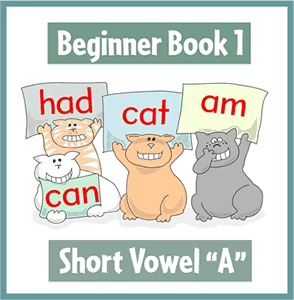 Al and Hal
Al and HalStory synopsis: Al the sheep learns to change his messy ways. Practices the letter "L" at the end of words.
Letters taught: Lowercase Letter 'L' at the end of words.
"Easier" version: Only has the words "al" and "hal" (both are boy's names).
Regular version: Words taught: al, at, sat. hal, can.
# of pages: 28
=============================
====================================
 Al and Hal
Al and HalStory synopsis: Al the sheep learns to change his messy ways. Practices the letter "L" at the end of words.
Letters taught: Lowercase Letter 'L' at the end of words.
"Easier" version: Only has the words "al" and "hal" (both are boy's names).
Regular version: Words taught: al, at, sat. hal, can.
# of pages: 28
=============================
=========================
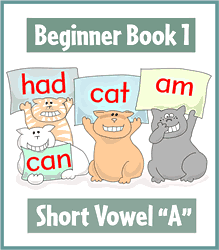 Al and Hal
Al and HalStory synopsis: Al the sheep learns to change his messy ways. Practices the letter "L" at the end of words.
Letters taught: Lowercase Letter 'L' at the end of words.
"Easier" version: Only has the words "al" and "hal" (both are boy's names).
Regular version: Words taught: al, at, sat. hal, can.
# of pages: 28
=============================
=======================
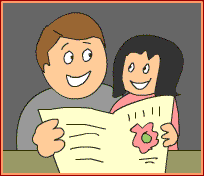 test copy blah de blah
test copy blah de blah
blah
test copy blah de blahblah
test copy blah de blahblah
test copy blah de blahblah
test copy blah de blahblah
test copy blah de blahblah
 Beginner Phonics Book 1
Beginner Phonics Book 1Short Vowel "A", focuses on short vowel "a" (can, man, had, etc.).
Number of pages: 50
Alpbabet letters used: c,a,t,s,m,r,d,h,n.
Words used: at, cat, hat, mat, rat, sat, am, ram, Sam, can, man, ran. Of these words, at, am, can, cat, man and ran are Dolch words. (See info on Dolch words.)
| # | Title | Download | Description | Size |
|---|---|---|---|---|
| Beginner Phonics Book 1 Short Vowel A |
Download
Open |
This is a version description. | 847.75 kb | |
| prep for pdf bigger |
Download
Open |
848.03 kb | ||
| prep for pdf bigger2 |
Download
Open |
849.51 kb |
Beginner Phonics Book 2
 Beginner Phonics Book 2
Beginner Phonics Book 2Short Vowel "E", focuses on short vowel "e" (red, yes, let, etc.) and teaches a fun trick on how to remember "b" versus "d."
Number of pages: 35
Alpbabet letter focus: e,b,l,v,w,y.
Words used: Ted, ten, red, bed, Ed,let, vet, wet, yet, yes (and the words bad and van). Of these words, ten, red and let are Dolch words. (See info on Dolch words.)
| # | Title | Download | Description | Size |
|---|---|---|---|---|
| Beginner Phonics Book 1 Short Vowel A |
Download
Open |
This is a version description. | 847.75 kb | |
| prep for pdf bigger |
Download
Open |
848.03 kb | ||
| prep for pdf bigger2 |
Download
Open |
849.51 kb |
 Beginner Phonics Book 1
Beginner Phonics Book 1Short Vowel "A", focuses on short vowel "a" (can, man, had, etc.).
Number of pages: 50
Alpbabet letters used: c,a,t,s,m,r,d,h,n.
Words used: at, cat, hat, mat, rat, sat, am, ram, Sam, can, man, ran. Of these words, at, am, can, cat, man and ran are Dolch words. (See info on Dolch words.)
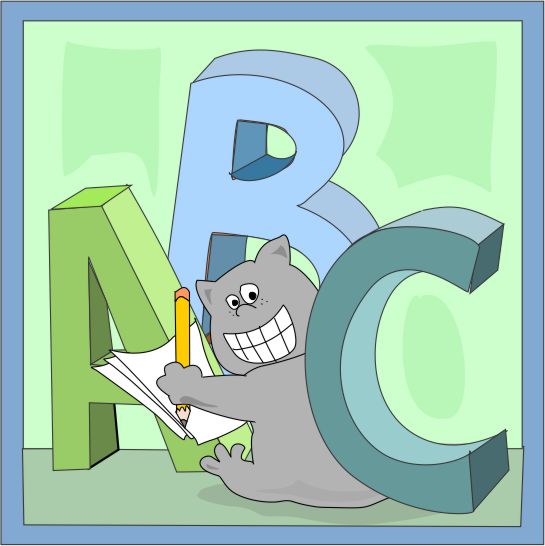 Capitals Made Easy!
Capitals Made Easy!The easiest and "free-est" program to learn capital letters!
And all 100% FREE!
![]()
The Captial Letter booklets are designed for children/students who can already read the 26 lowercase letters, so we recommend using the Booklets at any one of the following points:
-- After finishing the new (or old) Alphabetti books
-- After finishing the Beginner Phonics books
-- After finishing the Progressive Printing Beginner Handwriting program
Age: 4.5 - 7 years old and older.
NOTE: While our Capital Letter program isn't recommended for pre-school, some of the games/crafts CAN be used with younger children.
No experience necessary! Just pick up the first book and start teaching your child/students.
Format: Downloadable e-books to read on-screen or print on your printer.
Age: 4 - 7 years old. These books are for children who already know their alphabet. If a child struggles with letter recognition, use our Alphabetti books to resolve this.
Format: Downloadable e-books to read on-screen or print on your printer.
- See more at: http://progressivephonics.com/phonics-books/beginner-phonics-books#sthash.nHOBauZZ.dpufSave
Save
Save
Save
Teaches capital letters A, B, C, D & E
Also teaches --
-- that capital letters make the SAME sounds as the "little letters"
-- the first rule of capital letters (that all names start with a captial letter).
Eight easy lessons can be done one-lesson-a-day or two-lessons a day, depending on your schedule.
Age: 4.5 - 7 years old and older
# of pages:
Instructions & worksheets: 13 pages
Worksheets only: 8 pages
The "Worksheets Only" version contains only the worksheets (no instruction pages). This is for when you have more than one student -- save paper and ink!
Age: 4 - 7 years old. These books are for children who already know their alphabet. If a child struggles with letter recognition, use our Alphabetti books to resolve this.
Format: Downloadable e-books to read on-screen or print on your printer.
- See more at: http://progressivephonics.com/phonics-books/beginner-phonics-books#sthash.nHOBauZZ.dpufWhether we like it or not, teaching a child how to read requires a lot of repetition. Problem is, repetition can be boring, which is exactly what you DON'T want -- bored kids don't learn, they "tune-out."
The secret to repeition is to spread it out over time with a variety of activities, which is what our lesson plans and materials are designed to do.
You can use the Lesson Plans as-is (just as they are), or you can customize them to suit your needs.
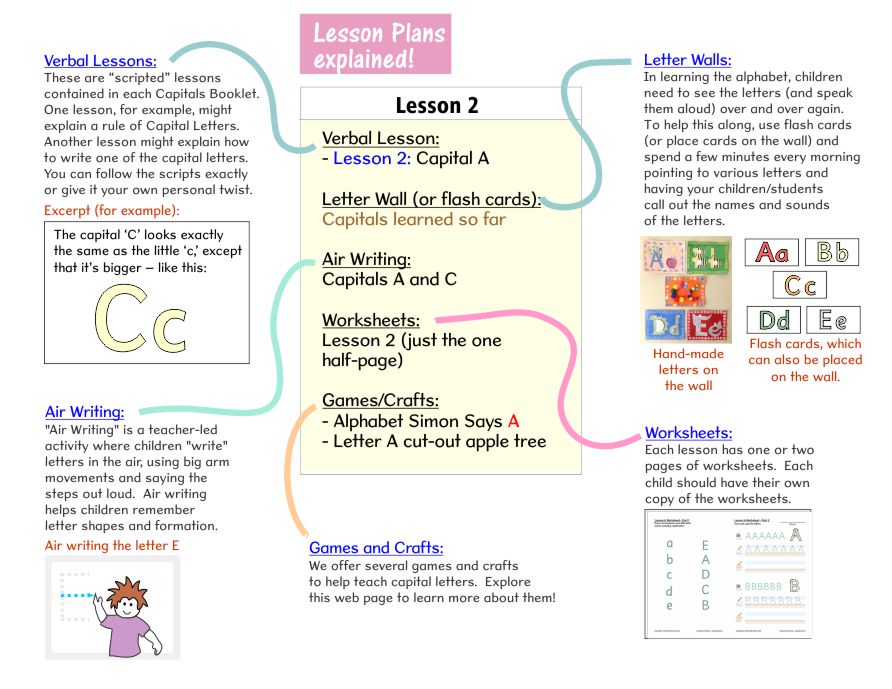
Teaches capital letters F, G, H, I & J
Also teaches --
-- that place names are also capitalized
-- the difference between several confusing letters
Twelve easy lessons can be done one-lesson-a-day or two-lessons a day, depending on your schedule.
Age: 4.5 - 7 years old and older
# of pages:
Instructions & worksheets: 15 pages
Worksheets only: 10 pages
The "Worksheets Only" version contains only the worksheets (no instruction pages). This is for when you have more than one student -- save paper and ink!
Age: 4 - 7 years old. These books are for children who already know their alphabet. If a child struggles with letter recognition, use our Alphabetti books to resolve this.
Format: Downloadable e-books to read on-screen or print on your printer.
- See more at: http://progressivephonics.com/phonics-books/beginner-phonics-books#sthash.nHOBauZZ.dpufWhether we like it or not, teaching a child how to read requires a lot of repetition. Problem is, repetition can be boring, which is exactly what you DON'T want -- bored kids don't learn, they "tune-out."
The secret to repeition is to spread it out over time with a variety of activities, which is what our lesson plans and materials are designed to do.
You can use the Lesson Plans as-is (just as they are), or you can customize them to suit your needs.

Teaches capital letters K, L, M, N & O
Also teaches that "things" (books, good, cleaning products, etc.) can have names, and these names are capitalized.
Nine easy lessons can be done one-lesson-a-day or two-lessons a day, depending on your schedule.
Age: 4.5 - 7 years old and older
# of pages:
Instructions & worksheets: 15 pages
Worksheets only: 8 pages
The "Worksheets Only" version contains only the worksheets (no instruction pages). This is for when you have more than one student -- save paper and ink!
Age: 4 - 7 years old. These books are for children who already know their alphabet. If a child struggles with letter recognition, use our Alphabetti books to resolve this.
Format: Downloadable e-books to read on-screen or print on your printer.
- See more at: http://progressivephonics.com/phonics-books/beginner-phonics-books#sthash.nHOBauZZ.dpufWhether we like it or not, teaching a child how to read requires a lot of repetition. Problem is, repetition can be boring, which is exactly what you DON'T want -- bored kids don't learn, they "tune-out."
The secret to repeition is to spread it out over time with a variety of activities, which is what our lesson plans and materials are designed to do.
You can use the Lesson Plans as-is (just as they are), or you can customize them to suit your needs.

Teaches capital letters P, Q, R, S & T
Eleven easy lessons can be done one-lesson-a-day or two-lessons a day, depending on your schedule.
Also teaches alphabet sequence with our Capital Candy activities (no sugar involved!).
Age: 4.5 - 7 years old and older
# of pages:
Instructions & worksheets: 17 pages
Worksheets only: 11 pages
The "Worksheets Only" version contains only the worksheets (no instruction pages). This is for when you have more than one student -- save paper and ink!
Age: 4 - 7 years old. These books are for children who already know their alphabet. If a child struggles with letter recognition, use our Alphabetti books to resolve this.
Format: Downloadable e-books to read on-screen or print on your printer.
- See more at: http://progressivephonics.com/phonics-books/beginner-phonics-books#sthash.nHOBauZZ.dpufWhether we like it or not, teaching a child how to read requires a lot of repetition. Problem is, repetition can be boring, which is exactly what you DON'T want -- bored kids don't learn, they "tune-out."
The secret to repeition is to spread it out over time with a variety of activities, which is what our lesson plans and materials are designed to do.
You can use the Lesson Plans as-is (just as they are), or you can customize them to suit your needs.

Teaches capital letters U, V, W, X, Y & Z
Nine easy lessons can be done one-lesson-a-day or two-lessons a day, depending on your schedule.
Age: 4.5 - 7 years old and older
# of pages:
Instructions & worksheets: 15 pages
Worksheets only: 10 pages
The "Worksheets Only" version contains only the worksheets (no instruction pages). This is for when you have more than one student -- save paper and ink!
Age: 4 - 7 years old. These books are for children who already know their alphabet. If a child struggles with letter recognition, use our Alphabetti books to resolve this.
Format: Downloadable e-books to read on-screen or print on your printer.
- See more at: http://progressivephonics.com/phonics-books/beginner-phonics-books#sthash.nHOBauZZ.dpuf
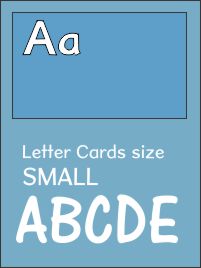
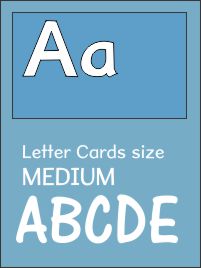
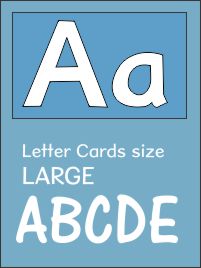 Letter cards can be placed on the wall as a visual aid or can be used as flash cards, which are held in your hand.
Letter cards can be placed on the wall as a visual aid or can be used as flash cards, which are held in your hand.
We have three different sizes (with or without the pictures) to accomodate your needs.
The small-size letter cards come with and without pictures. The small sized cards can be used as flash cards and also for letter matching activities. Print the pages you need from the file provided.
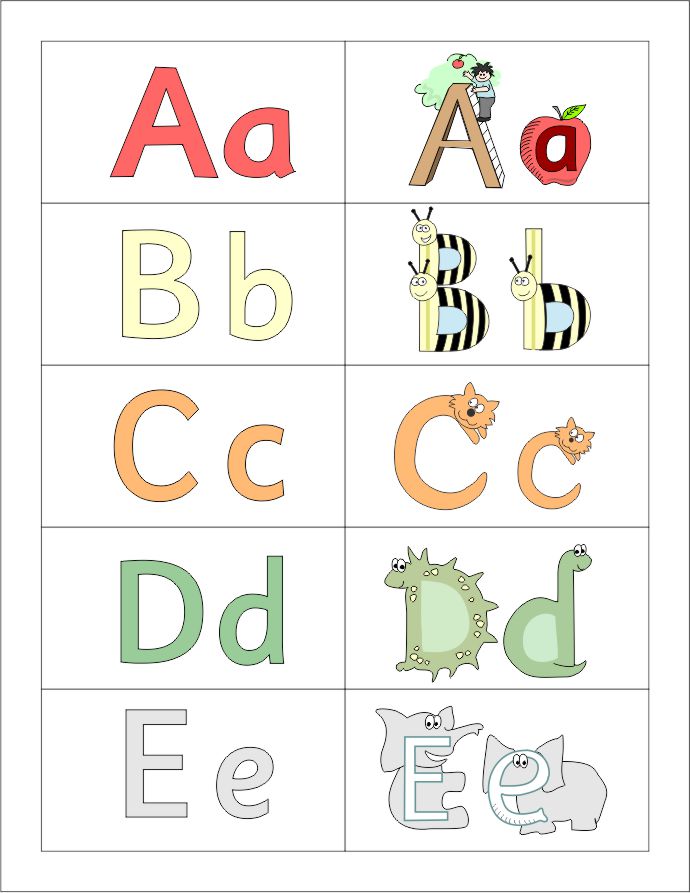
The medium-sized letter cards come with and without pictures. They can be used to make a "letter wall" (where you put the alphabet letters on the wall) and also can be used as flash cards when you are working with more than one or two students. Print the pages you need from the file provided.
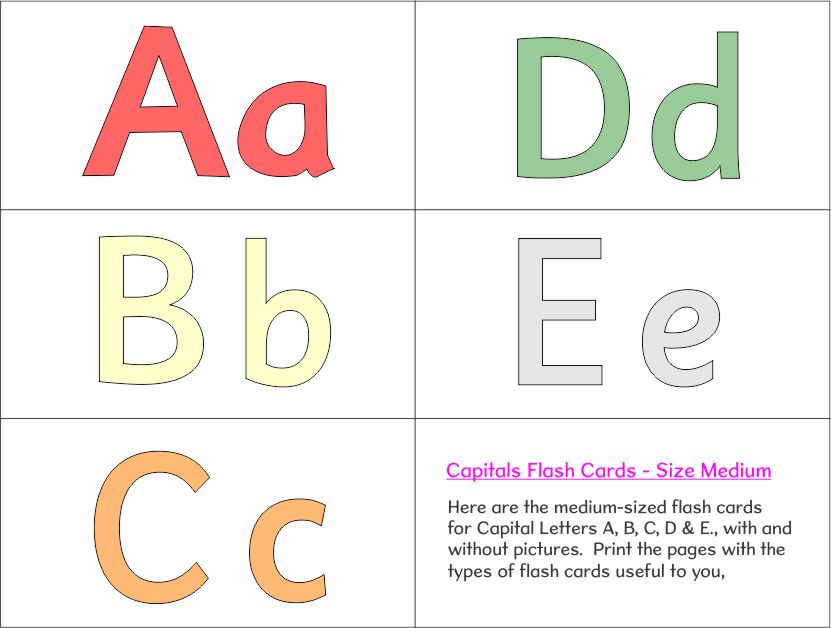
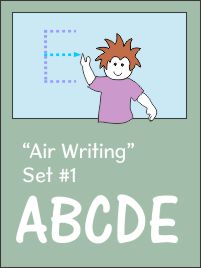 "Air Writing" is a teacher-led activity where the children "write" the letters in the air, using big arm movements. Children also verbalize (speak out loud) the steps to form the letter.
"Air Writing" is a teacher-led activity where the children "write" the letters in the air, using big arm movements. Children also verbalize (speak out loud) the steps to form the letter.
Air writing helps children remember letter formation, which is a motion-oriented "memory," and which is an entirely different (and separate) memory than the visual memories of letter shapes.
Air writing also helps to strengthen the arm and shoulder muscles in preparation for handwriting. This is important because weak muscles lead to bad habits in handwriting.
We recommend spending a few minutes a day on Air Writing, just before your daily handwriting or pre-handwriting practice.
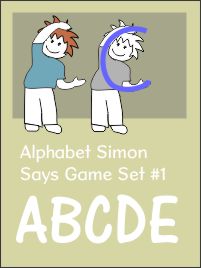 The popular children's game, Simon Says, can be educational as well as fun.
The popular children's game, Simon Says, can be educational as well as fun.
Playing this game helps to speed-up (make faster) a child's recall of the various letters. This is important because speed-of-recollection is a major factor in literacy.
The only "downside" is that the game can become quite rowdy, so you may want to schedule some break-time after playing this game.
Save
Save
Save
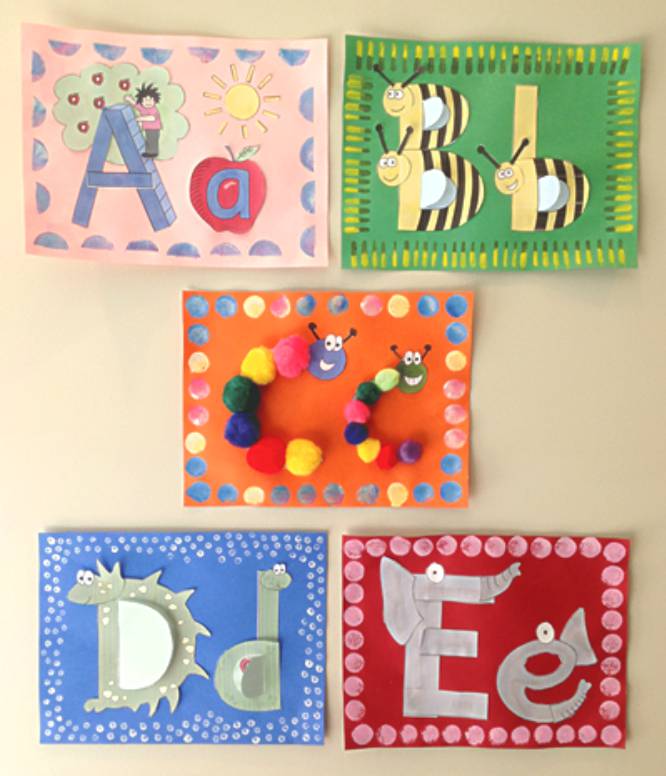 Make your own colorful capital letters to display on the wall. All you need is some paper (I used colored construction paper), some glue (any non-toxic glue will do), safety scissors and poster paints (I used Crayola "Washable Kids Paint") which can all be bought at a Dollar-Store or (with coupons!) at a craft store such as Jo-Ann's or Michaels.
Make your own colorful capital letters to display on the wall. All you need is some paper (I used colored construction paper), some glue (any non-toxic glue will do), safety scissors and poster paints (I used Crayola "Washable Kids Paint") which can all be bought at a Dollar-Store or (with coupons!) at a craft store such as Jo-Ann's or Michaels.
If you have a color printer, and you want to save some time and mess, print the "Pre-colored" version. That way, all you have to decorate is the piece of paper/construction paper that will be the base/frame for your cut-out creation. (This is what I did for the photos.)
But if you want to really go for it, print the Ready-To-Color version and color everything in your own custom colors.
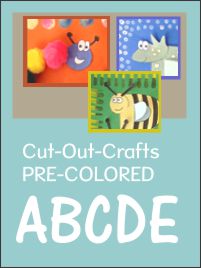
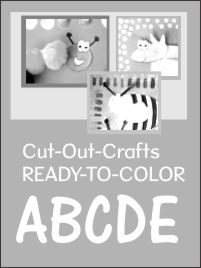
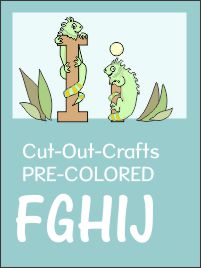
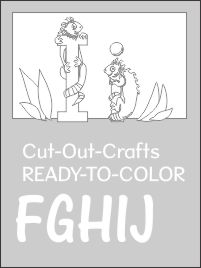
Save
Save
Save
Save
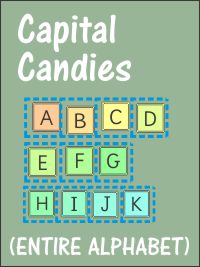 Learning the alphabet sequence is a major milestone in a child's education. Unfortunately, it's rather boring because it requires a lot of repetition.
Learning the alphabet sequence is a major milestone in a child's education. Unfortunately, it's rather boring because it requires a lot of repetition.
Until we have a fun app for this chore, our "Capital Candy" game is the best we can offer. See the instructions for some suggestions on how to make it a little more easy/fun.
Save
Save
Save
Save
Save
Save
Save
Save
Save
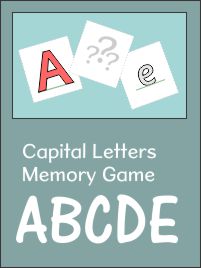 Also called "Concentration," the "Memory Game" is a game where cards are placed face-down on a table or the floor, and players take turns trying to match up pairs of cards. To make this an educational game, we use alphabet letter-cards instead of regular playing cards.
Also called "Concentration," the "Memory Game" is a game where cards are placed face-down on a table or the floor, and players take turns trying to match up pairs of cards. To make this an educational game, we use alphabet letter-cards instead of regular playing cards.
NOTE: I created special, fold-over cards for this game becase regular paper is slightly see-through and card stock (thicker paper) is ridiculously expensive. If you are super-crafty, you can create your own cards using construction paper.
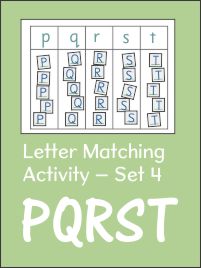 While the Memory Game (above) requires more than one player, you only need one child for the "Letter Sorting Activity."
While the Memory Game (above) requires more than one player, you only need one child for the "Letter Sorting Activity."
You simply print two pages -- one page is the "grid" with the lowercase letters on top, and the second page contains the capital letters that you (or your little helper) cuts out. To play, a child takes the pile of cut-out capital letters and sorts them into the correct column on the grid.
 Best Alphabet Cards Ever!
Best Alphabet Cards Ever!The letter-sound connection is important because alphabet training doesn't depend on just the visuals (the letter shapes). Alphabet training also depends on children's EARS -- their ability to pick out the individual letter-sounds in the ocean of our language.
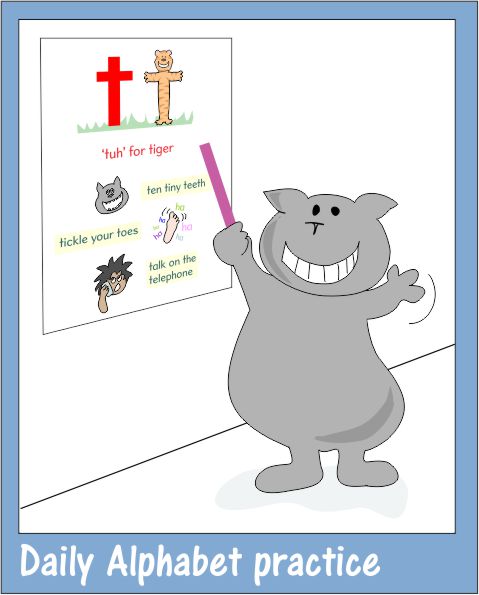
In learning the alphabet, children need to see the letters (and speak them aloud) over and over again.
To help this along, use flash cards (or tape cards to the wall) and spend a few minutes each day practicing the letters:
– Point to a letter and say the letter’s name and/or sound.
– Say ONE of the lines under the letter, for example,
“ten tiny teeth” is one of the lines for the letter ‘t’
– Then have your children/students repeat what you
just said. (This is NOT a silent exercise.)
On a different day, choose a different practice phrase. (Each letter has three different practice phrases.)
![]()
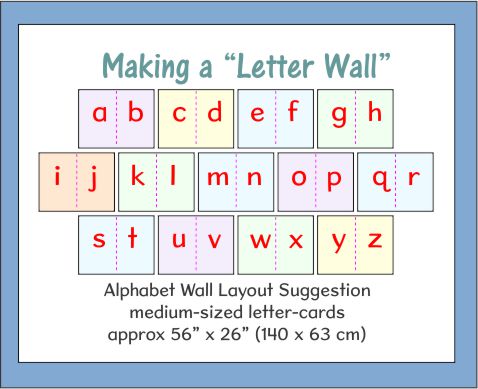
It helps to have a “Letter Wall” – a display of alphabet letters up on the wall. Children use it as a reference, and it’s very convenient for daily alphabet practice.
If space is limited, use the “Medium” letter cards (two letters per sheet of paper). Depending on how you lay it out, space requirements are about 56”x 26” (140 x 63 cm).
If you have a large classroom, use the “Large” letter cards (one letter per sheet of paper).
If you have no wall space, use the letter cards as flash cards (cards that you hold in your hand).
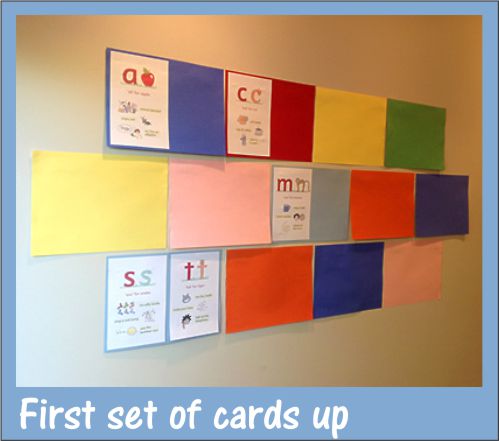
If your children have worked on the alphabet before, put ALL the letters on the wall. But if the alphabet is a new subject, or if your children are struggling with the alphabet, put up the letters one-by-one or in “sets.”
For example, with Alphabetti the system, you would start with the first letter set (c,a,t,s,m).
For Montessori schooling, you put up their first batch of letters – c,m,a,t (or s,m,t,a,p,f,c - or a different set, depending on the “brand” of Montessori you’re using).
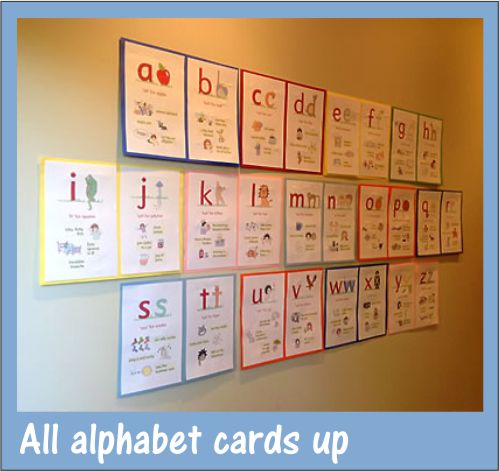
This makes it easy to practice the alphabet every day – the focus letters (and the letters you’ve already learned) are right there, and you don’t have to worry about which letters you haven't learned yet.
In the photographs to the left, I put thirteen sheets of 9x13” construction paper on the wall. Then I added the first set of letters (c,a,t,s,m). Then I added the rest of the alphabet.
Finished size was 61” x 28” (155x70 cm).
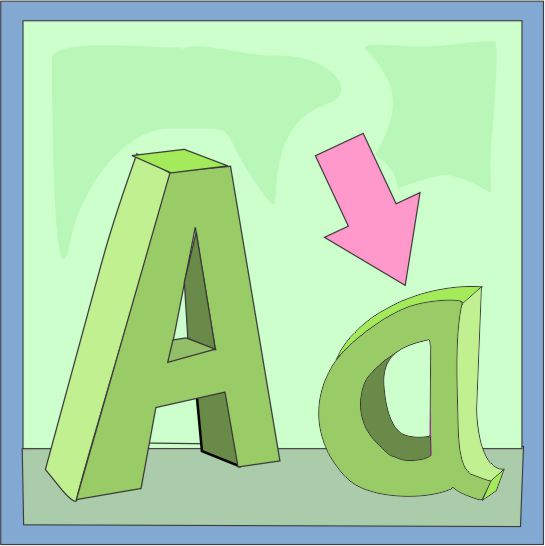 Lowercase first!
Lowercase first!When children learn the alphabet, they naturally want to "apply" (use) their new-found knowledge and skills -- they are very proud of themselves! So they will scan books and all sorts of written materials around them to see if they can spot (see) the letters they're learning.
95% of all texts are written with lowercase letters, so children who learn lowercase first can spot/see waaaaay more letters. Even better, they are able to start following-along (reading the text) when teachers, parents and/or caregivers read stories to them.
I've never seen a children's book that was written in all-capitals, so for me, that's the "clincher" -- the deal breaker.
Please excuse me for jumping up and down on a soapbox, but if you want to limit your "teachable moments" to store-signs, advertising slogans and newspaper headlines, go ahead and teach capitals first. If you want to open the world of books to a child, go with lowercase first.
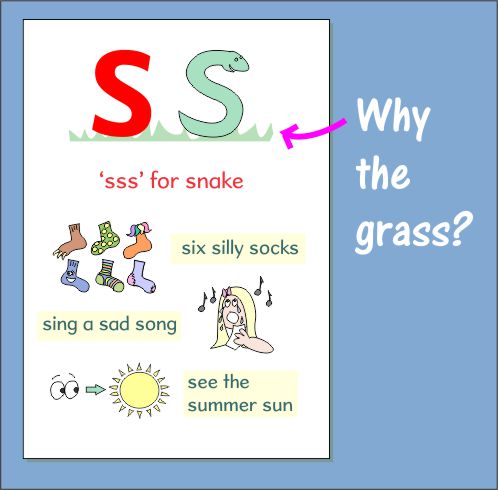 The "green grass" represents the base line (the line that all letters "sit" on).
The "green grass" represents the base line (the line that all letters "sit" on).
In our handwriting booklets, we call this base line the "grass line" because it's easy to explain to children that "all letters sit on the grass." So, we use the same imagery in our alphabet cards to keep things consistent.
Good to know: Only five letters in the alphabet "drop" below the base line: g, j, p, q & y. The 26 capital letters and the remaining 21 lowercase letters ALL sit on the "grass" (the base line).